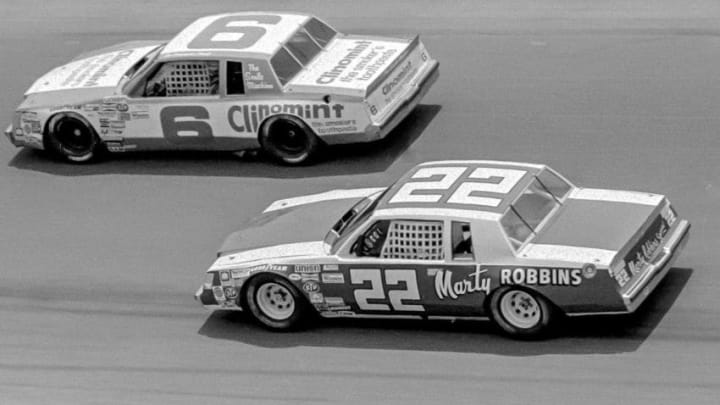If not for Marty Robbins, seven-time Cup Series champion Dale Earnhardt would have had a radically different-looking NASCAR career.
NASCAR and the country music community have long intersected. After all, NASCAR makes two annual trips to Bristol, Tennessee, coined the “birthplace of country music”, and visits many other cities where country reigns supreme as well. There’s just something about the potent combination of the fast cars and country music that makes it irresistible.
One fan in particular found it uncommonly irresistible. Country music legend Marty Robbins became infatuated with the sport upon his arrival to Nashville in the mid-1960s.
As a newcomer to Tennessee and stock car racing itself, the country crooner of “El Paso” and “White Sport Coat” fame became attracted to the sport at Nashville Fairgrounds Speedway.
The fandom eventually gave way to him becoming a racer himself. He had the audacity, money and access, so why not? It was much easier in those days, and provided the means, anyone reading this article would probably have done the same.
Naturally his car, dubbed “Devil Woman”, was the same magenta and chartreuse (exactly the same colors as your local Planet Fitness) color scheme as the car featured on the cover of his album by the same name.
Although he was never a full-time driver, he made 21 Cup Series appearances from 1966 to 1974, and his best finish was a fifth place finish at Michigan International Speedway in 1974.
Regarded as something of a novelty, he endured his share of ribbing from the seasoned Cup Series drivers who enjoyed poking fun at his lack of car knowledge. It was all in good fun, though.
More from NASCAR Cup Series
- NASCAR Cup Series: New team set to compete in 2024
- NASCAR: Surprising name continuously linked to new seat
- NASCAR driver at risk of missing the Daytona 500?
- NASCAR set for rare appearance last seen 13 years ago
- NASCAR team adds third car, names driver for 2024 Daytona 500
Robbins’ moment of greatness came at the 1974 National 500 at Charlotte Motor Speedway. Although it didn’t end in victory lane, it was definitely memorable.
In an effort to avoid an early pileup, which rendered several cars unable to move off the track, Robbins selflessly steered his car, at 160 miles per hour, into the wall. He avoided hitting the stranded, wrecked drivers. He survived the crash, but he did sustain serious, albeit non life-threatening, injuries.
After the race, Robbins explained his rationale.
“The only thing I knew was that there were people in those wrecked cars in front of me and I couldn’t hit one of them because they’d probably not walk away from it,” he said.
It was indeed a tremendous act of bravery, but who he avoided hitting is the real story.
One of those wrecked drivers was Richard Childress, who later founded Richard Childress Racing (RCR) and employed one Dale Earnhardt, who went on to become a seven-time Cup Series champion and 76-time race winner.
Had Robbins not sacrificed his car and risked his life, there may not have been an RCR, and the name Earnhardt would have been synonymous with another team. Childress still credits Robbins for saving his life, and he regards the selfless act almost unbelievable.
Robbins would go on to appear in select races until his passing in 1982. He competed in 35 races total from 1966 to 1982. In honor of Robbins and his love for NASCAR, the 1983 race at Nashville was appropriately named the “Marty Robbins 420”.
Earnhardt would pass away following a last-lap Daytona 500 crash 20 years ago today.
